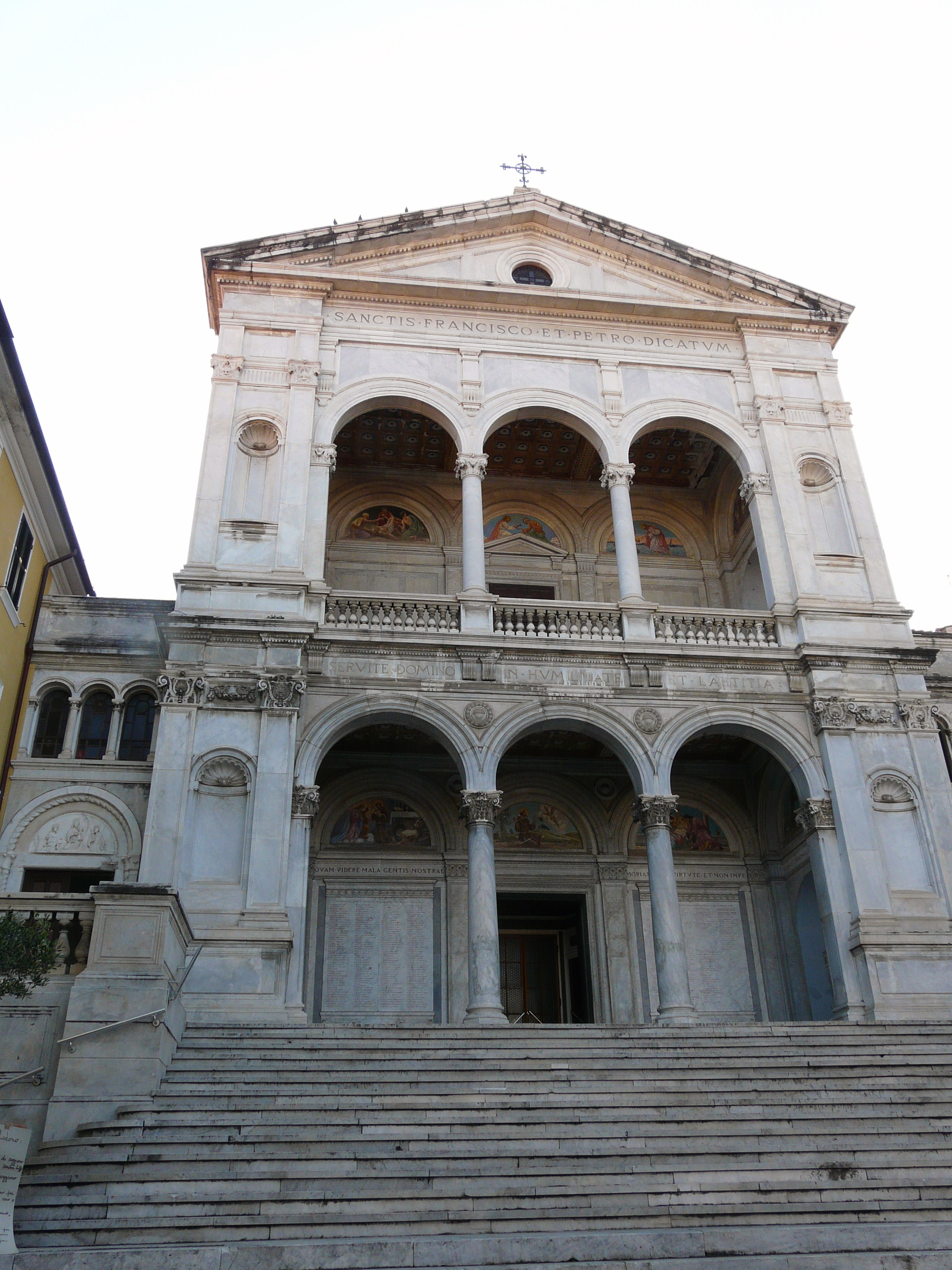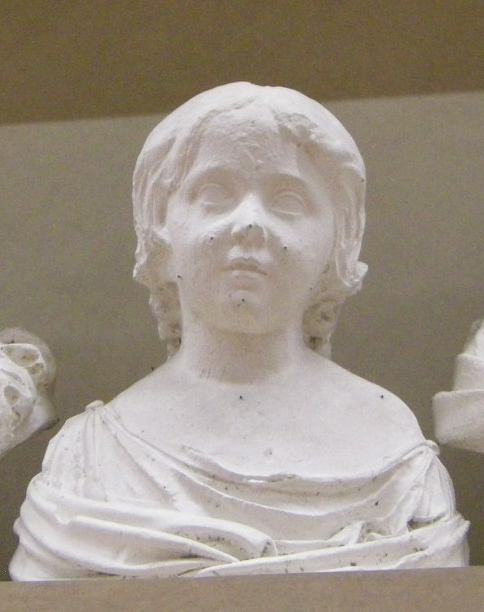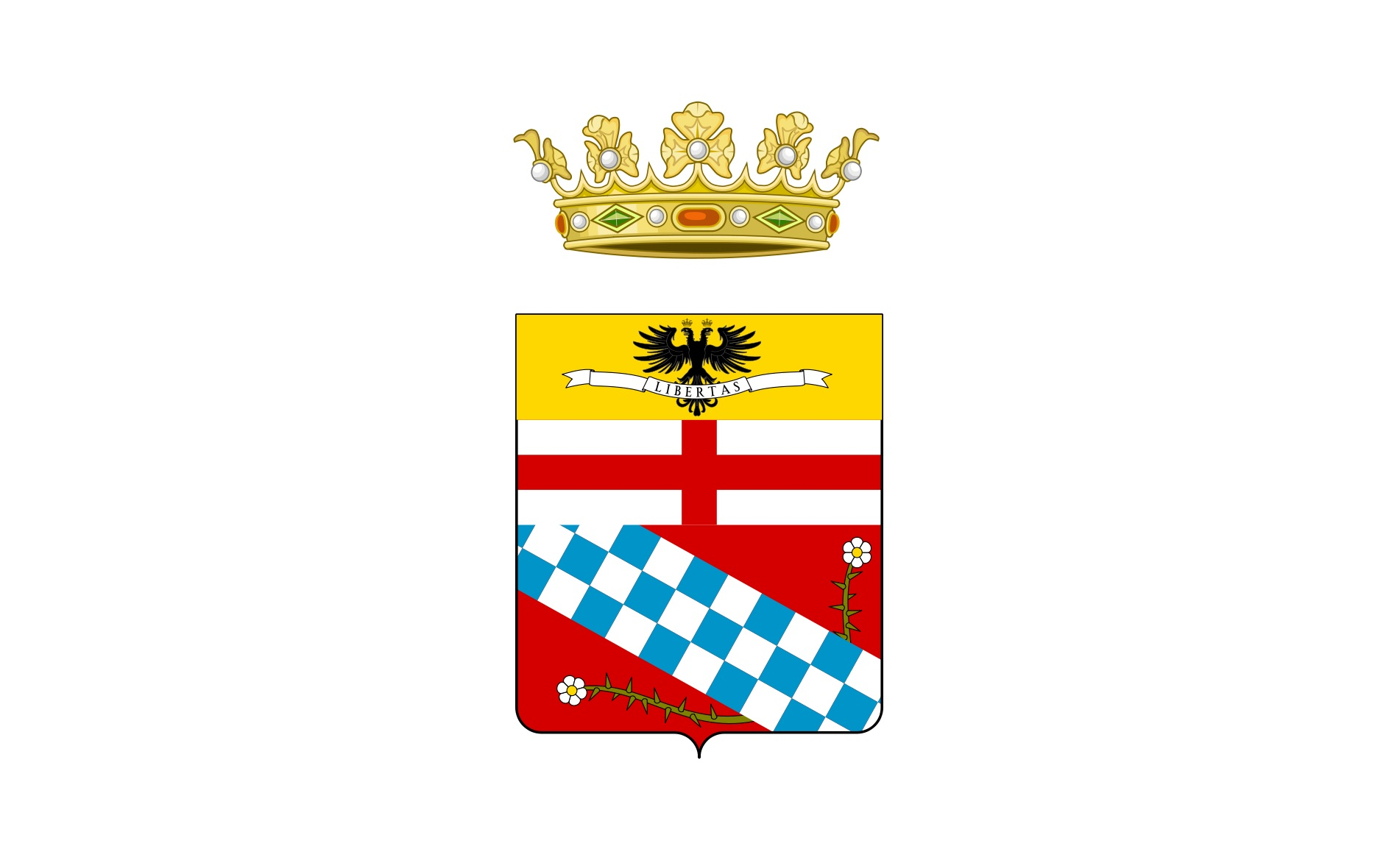|
Cathedral Of Massa
Massa Cathedral ( it, Duomo di Massa; Cattedrale dei Santi Pietro e Francesco) is a Roman Catholic cathedral in Massa, Tuscany, central Italy. It is dedicated to Saints Peter and Francis. Formerly a conventual church, it was declared the episcopal seat of the Diocese of Massa Carrara at its creation in 1822, and is now the seat of the bishop of Massa Carrara-Pontremoli.not to be confused with the so-called Cathedral of St. Sebastian, a large church in the same city. History The church originated as a pieve dedicated to Saint Peter, enlarged in the 16th and 17th century. It became a collegiate church in 1629. In 1672, the building collapsed, and at the end of the century was replaced by a new one, designed by Alessandro Bergamini. This construction was demolished by order of duchess Elisa Bonaparte (sister of Napoleon) in 1807, when the dedication to Saint Peter was transferred to the church of Saint Francis in Massa, which had been reconstructed in 1660–1670. This church had ... [...More Info...] [...Related Items...] OR: [Wikipedia] [Google] [Baidu] |
Elisa Bonaparte
Maria Anna Elisa Bonaparte Baciocchi Levoy (French language, French: ''Marie Anne Elisa Bonaparte''; 3 January 1777 – 7 August 1820), better known as Elisa Bonaparte, was an imperial French princess and sister of Napoleon, Napoleon Bonaparte. She was Principality of Lucca and Piombino, Princess of Lucca and Piombino (1805-1814), Grand Duchess of Tuscany (1809-1814) and Countess of Compignano by appointment of her brother. She was the fourth surviving child and eldest surviving daughter of Carlo Buonaparte and Letizia Ramolino. A younger sister of Napoleon, Napoleon Bonaparte, she had elder brothers Joseph Bonaparte, Joseph and Lucien Bonaparte, Lucien, and younger siblings Louis Bonaparte, Louis, Pauline Bonaparte, Pauline, Caroline Bonaparte, Caroline and Jérôme Bonaparte, Jerome. As Princess of Lucca and Piombino, then Grand Duchess of Tuscany, she became Napoleon's only sister to possess political power. Their relations were sometimes strained due to her sharp tongue. Hi ... [...More Info...] [...Related Items...] OR: [Wikipedia] [Google] [Baidu] |
Baroque Architecture In Tuscany
The Baroque (, ; ) is a style of architecture, music, dance, painting, sculpture, poetry, and other arts that flourished in Europe from the early 17th century until the 1750s. In the territories of the Spanish and Portuguese empires including the Iberian Peninsula it continued, together with new styles, until the first decade of the 19th century. It followed Renaissance art and Mannerism and preceded the Rococo (in the past often referred to as "late Baroque") and Neoclassical styles. It was encouraged by the Catholic Church as a means to counter the simplicity and austerity of Protestant architecture, art, and music, though Lutheran Baroque art developed in parts of Europe as well. The Baroque style used contrast, movement, exuberant detail, deep colour, grandeur, and surprise to achieve a sense of awe. The style began at the start of the 17th century in Rome, then spread rapidly to France, northern Italy, Spain, and Portugal, then to Austria, southern Germany, and Russia. By ... [...More Info...] [...Related Items...] OR: [Wikipedia] [Google] [Baidu] |
Churches In The Province Of Massa And Carrara
Church may refer to: Religion * Church (building), a building for Christian religious activities * Church (congregation), a local congregation of a Christian denomination * Church service, a formalized period of Christian communal worship * Christian denomination, a Christian organization with distinct doctrine and practice * Christian Church, either the collective body of all Christian believers, or early Christianity Places United Kingdom * Church (Liverpool ward), a Liverpool City Council ward * Church (Reading ward), a Reading Borough Council ward * Church (Sefton ward), a Metropolitan Borough of Sefton ward * Church, Lancashire, England United States * Church, Iowa, an unincorporated community * Church Lake, a lake in Minnesota Arts, entertainment, and media * ''Church magazine'', a pastoral theology magazine published by the National Pastoral Life Center Fictional entities * Church (''Red vs. Blue''), a fictional character in the video web series ''Red vs. Blue'' * Churc ... [...More Info...] [...Related Items...] OR: [Wikipedia] [Google] [Baidu] |
Diocese Of Massa
The Italian Catholic Diocese of Massa Carrara-Pontremoli ( la, Dioecesis Massensis-Apuana) is in Tuscany. It is a suffragan of the Archdiocese of Pisa. The historical Diocese of Massa Carrara had its name changed in 1939 to Diocese of Apuania; and again in 1986 to Diocese of Massa. In 1988 it was united with the Diocese of Pontremoli."Diocese of Massa Carrara-Pontremoli" ''''. David M. Cheney. Retrieved February 29, 2016"Diocese of Massa Carrara-Pontremoli" [...More Info...] [...Related Items...] OR: [Wikipedia] [Google] [Baidu] |
Malaspina Family
The House of Malaspina was a noble Italian family of Longobard origin that descended from Boniface I, Margrave of Tuscany, Boniface I, through the Obertenghi line, that ruled Lunigiana from the 13th to the 14th centuries, and the Province of Massa and Carrara, marquisate of Massa and lordship of Carrara (which later became the Duchy of Massa and Carrara and at a later time the Principality of Massa and the Marquisate of Carrara) since the 14th century. History The founder of the Malaspina family was Oberto I, who became the count of Luni, Italy, Luni in 945. Oberto I was appointed as the marquise of the March of Genoa under the Italian king Berengar II of Italy, Berengario II in 951 and he became a count palatine in 953. Oberto I had two children; Oberto II, who inherited the title of count of Luni from his father, and Adalberto I, whose offspring founded the Pallavicino and the Cavalcabò families. Oberto II had four children; Bertha of Milan, the spouse of the King of Italy ... [...More Info...] [...Related Items...] OR: [Wikipedia] [Google] [Baidu] |
Luigi Garzi
Luigi Garzi (1638 – 1721) was an Italian painter of the Baroque period, whose work displayed heavy influences of the Bolognese painter, Guido Reni. Biography Born in Pistoia. He started learning from a poorly known landscape painter, Salomon Boccali. But at age 15, he moved to Rome, where he was one of the main pupils of Andrea Sacchi. He is also often referred to as ''Ludovico Garzi''. In 1680 Garzi was appointed Regent of the ''Congregazione dei Virtuosi al Pantheon'', the papal society of painters. Garzi joined Rome's guild of painters, The Accademia di San Luca, in 1670 and became a director in 1682. He painted a ''Triumph of St Catherine & Saints'' for the church of Santa Caterina a Magnanapoli in Rome. He painted a ''St Silvestro shows Constantine portraits of Saints Peter and Paul'' for Santa Croce in Gerusalemme. In the early 1680s, he contributed to the frescoes on the vault of San Carlo al Corso, where his works included an ''Allegory of Faith''. He also complete ... [...More Info...] [...Related Items...] OR: [Wikipedia] [Google] [Baidu] |
Carlo Maratta
Carlo Maratta or Maratti (13 May 162515 December 1713) was an Italian painter, active mostly in Rome, and known principally for his classicizing paintings executed in a Late Baroque Classical manner. Although he is part of the classical tradition stemming from Raphael, he was not exempt from the influence of Baroque painting and particularly in his use of colour. His contemporary and friend, Giovanni Bellori, wrote an early biography on Maratta. Biography Born in Camerano (Marche), then part of the Papal States, Maratta went to Rome in 1636, accompanied by, Don Corintio Benicampi, secretary to Taddeo Barberini. He became an apprentice in the studio of Andrea Sacchi. It was at this time that the debate between Sacchi and Pietro da Cortona took place at the Accademia di San Luca, the artists academy in Rome. Sacchi argued that paintings should only have a few figures which should express the narrative whereas Cortona countered that a greater number of figures allowed for the develop ... [...More Info...] [...Related Items...] OR: [Wikipedia] [Google] [Baidu] |
Transept
A transept (with two semitransepts) is a transverse part of any building, which lies across the main body of the building. In cruciform churches, a transept is an area set crosswise to the nave in a cruciform ("cross-shaped") building within the Romanesque and Gothic Christian church architectural traditions. Each half of a transept is known as a semitransept. Description The transept of a church separates the nave from the sanctuary, apse, choir, chevet, presbytery, or chancel. The transepts cross the nave at the crossing, which belongs equally to the main nave axis and to the transept. Upon its four piers, the crossing may support a spire (e.g., Salisbury Cathedral), a central tower (e.g., Gloucester Cathedral) or a crossing dome (e.g., St Paul's Cathedral). Since the altar is usually located at the east end of a church, a transept extends to the north and south. The north and south end walls often hold decorated windows of stained glass, such as rose windows, in sto ... [...More Info...] [...Related Items...] OR: [Wikipedia] [Google] [Baidu] |
Napoleon
Napoleon Bonaparte ; it, Napoleone Bonaparte, ; co, Napulione Buonaparte. (born Napoleone Buonaparte; 15 August 1769 – 5 May 1821), later known by his regnal name Napoleon I, was a French military commander and political leader who rose to prominence during the French Revolution and led successful campaigns during the Revolutionary Wars. He was the ''de facto'' leader of the French Republic as First Consul from 1799 to 1804, then Emperor of the French from 1804 until 1814 and again in 1815. Napoleon's political and cultural legacy endures to this day, as a highly celebrated and controversial leader. He initiated many liberal reforms that have persisted in society, and is considered one of the greatest military commanders in history. His wars and campaigns are studied by militaries all over the world. Between three and six million civilians and soldiers perished in what became known as the Napoleonic Wars. Napoleon was born on the island of Corsica, not long af ... [...More Info...] [...Related Items...] OR: [Wikipedia] [Google] [Baidu] |
Collegiate Church
In Christianity, a collegiate church is a church where the daily office of worship is maintained by a college of canons: a non-monastic or "secular" community of clergy, organised as a self-governing corporate body, which may be presided over by a dean or provost. In its governance and religious observance a collegiate church is similar to a cathedral, although a collegiate church is not the seat of a bishop and has no diocesan responsibilities. Collegiate churches were often supported by extensive lands held by the church, or by tithe income from appropriated benefices. They commonly provide distinct spaces for congregational worship and for the choir offices of their clerical community. History In the early medieval period, before the development of the parish system in Western Christianity, many new church foundations were staffed by groups of secular priests, living a communal life and serving an extensive territory. In England these churches were termed minsters, from th ... [...More Info...] [...Related Items...] OR: [Wikipedia] [Google] [Baidu] |
Roman Catholic
Roman or Romans most often refers to: *Rome, the capital city of Italy *Ancient Rome, Roman civilization from 8th century BC to 5th century AD *Roman people, the people of ancient Rome *'' Epistle to the Romans'', shortened to ''Romans'', a letter in the New Testament of the Christian Bible Roman or Romans may also refer to: Arts and entertainment Music * Romans (band), a Japanese pop group * ''Roman'' (album), by Sound Horizon, 2006 * ''Roman'' (EP), by Teen Top, 2011 *" Roman (My Dear Boy)", a 2004 single by Morning Musume Film and television * Film Roman, an American animation studio * ''Roman'' (film), a 2006 American suspense-horror film * ''Romans'' (2013 film), an Indian Malayalam comedy film * ''Romans'' (2017 film), a British drama film * ''The Romans'' (''Doctor Who''), a serial in British TV series People *Roman (given name), a given name, including a list of people and fictional characters *Roman (surname), including a list of people named Roman or Romans *ῬωμΠ... [...More Info...] [...Related Items...] OR: [Wikipedia] [Google] [Baidu] |





